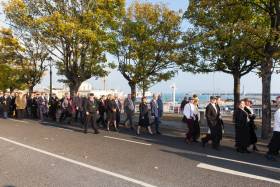Displaying items by tag: Welsh First Minister
First Minister of Wales Attends RMS Leinster Commemoration Centenary
#rmsLeinster - The First Minister of Wales along with Irish dignitaries, ambassadors among them from the UK and Germany attended in Dun Laoghaire yesterday a state commemoration ceremony on the centenary of the sinking of RMS Leinster, writes Jehan Ashmore.
First Minister, Carwyn Jones marked the historic occason with DLRCoCo Cathaoirleach Ossian Smyth and Irish Minister for Culture, Heritage and the Gaeltacht, Josepha Madigan beside the Lexicon Library. The public ceremony involved invited guests and hundreds of relatives of RMS Leinster including those from overseas at close to the harbour's Carlisle Pier from where the steamer made its final departure on that fateful day, 100 years ago on October, 10th 1918.
During the ceremony, a minute of silence took place while offshore the Naval Service L.E. Orla anchored in Scotmens Bay having completed earlier in the morning a memorial trip as part of floltilla out to the site of the wreck. Relatives were on board excursion vessel St. Bridget while local lifeboat, RNLB Anna Livia also took part in the laying of wreaths in rememberance to the victims of the disaster. Also yesterday morning, a ferry from Holyhead, Stena Superfast X paid tribute at the wreck site while making a routine crossing bound for Dublin Port.
The RMS Leinster was operated by the City of Dublin Steam Packet Company which had the prestigious contract to carry mail for the British post office service, hence the Royal Mail Steamer prefix of RMS was given to the name of the passenger ship built by Laird Brothers, Birkenhead in 1896.
At the time 100 year ago, the City of Dublin Steam Packet Co. operated steamer was serving the Kingstown (Dun Laoghaire)-Holyhead service, though because of World War One, RMS Leinster was painted in 'Dazzle Camouflage ' in an attempt to avoid detection by enemy attack.
RMS Leinster however became a casualty of war, having departed Kingstown on a routine sailing, the passenger and mail-boat steamer would never complete the crossing to the north Wales port town on Anglesea. It was off the Kish Bank skirting Dublin Bay, when RMS Leinster was struck by torpedoes from German submarine U-Boat 123 resulting in more than 560 victims (mostly military personnel) which remains the greatest single tragedy on the Irish Sea.
Asides the crew, the postal sorters working on board and civilian passengers, the majority losing their lives were militiary personnel who were either leaving or returning from leave. The military included sailors, soldiers, airmen and military nurses from Ireland, UK, Australia, New Zealand, Canada and the United States.
The disaster occured only one month and a day to the signing on Armistice Day, 11th November, making the end of World War One.
The ceremony also commemorated the loss of the crew from the U-Boat when a week after the attack on RMS Leinster, a mine struck the submarine in the North Sea.
On the other side of the Irish Sea yesterday, a centenary event held in Holyhead, is where the Daily Post reports of hundreds of people lining the street of the town as a procession walked in silence from St Cybi’s Church to the Cenotaph where flags were lowered and wreaths were laid.
A minute’s silence followed the sounding of the Last Post by a lone trumpeter. Children from primary schools in the town were among those paying their own poignant tribute. Earlier, at the service in the church, a roll of honour was read. For more click here.
























































